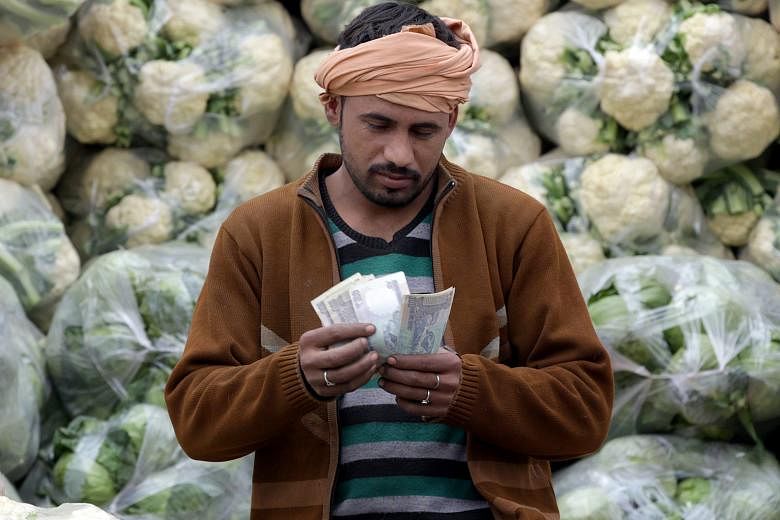Deposits in no-frills bank accounts of India's rural poor have nearly doubled since the country demonetised 500-rupee (S$10) and 1,000- rupee notes, raising a few eyebrows in the Finance Ministry.
Officials suspect that individuals with vast piles of undeclared cash are persuading the poor to launder money for them, and the Income Tax Department is reported to be now "dissecting" many transactions, warning that anyone facilitating the misuse of their accounts would be prosecuted.
Since Indian Prime Minister Narendra Modi announced on Nov 8 that he was demonetising the two most common banknotes in the country in a bid to stem corruption and counterfeiting, deposits in banks have nearly doubled to 871 billion rupees in over 220 million Jan Dhan accounts. These are zero-balance accounts that do not require any funds to be maintained.
When Mr Modi's government introduced this no-frills bank account scheme in August 2014 to include India's rural poor in the financial system, just 272.8 billion rupees were accumulated in 16 months.
But between the demonetisation announcement in early November and Dec 23, as much as 415.2 billion rupees in new deposits have been made.
-
Busted after demonetisation
-
A number of people have been nabbed with large quantities of new rupee notes and other undeclared assets. Several bank officials have been also arrested for facilitating the laundering of illicit funds. Amid the chaos caused by India's demonetisation drive, here is a look at some of the biggest busts:
DEC 5
The Enforcement Directorate arrested two managers at Axis Bank in New Delhi for facilitating the deposit of 390 million rupees (S$8.2 million) in their branch's account. Gold bars weighing 3kg, which were apparently given as a quid pro quo for the duo's assistance, were seized.
DEC 8
Raids in eight locations in Chennai on Dec 8 led to the seizure of 900 million rupees in cash and 100kg of gold. A trio of businessmen believed to have links to the ruling party in the state of Tamil Nadu were questioned. Of the cash, 700 million rupees was in new 2,000-rupee notes.
In another raid in Chennai on Dec 8, the tax department seized 680 million rupees of currency and 75kg of gold. Out of the cash seized, 80 million rupees was in new notes.
DEC 14
The Central Bureau of Investigation arrested two officials of the Reserve Bank of India (RBI) over the unauthorised exchange of demonetised notes amounting to 19.9 million rupees.
In addition, the officials gave away 19.9 million rupees in new notes to RBI officials and others.
DEC 15
The tax department found over 100 million rupees, most of it in new 2,000-rupee notes, during a raid of multiple lockers maintained at a bank branch in the city of Pune. The lockers allegedly belonged to a United States-based multinational company.
DEC 22
The Enforcement Directorate arrested a businessman in Kolkata for converting 250 million rupees of old currency into new notes.
DEC 28
A Kotak Bank branch manager was arrested in New Delhi for facilitating the deposit of old currency amounting to 340 million rupees into nine fake accounts.
Notably, the new deposits came only into 4.8 million accounts, just 2.1 per cent of the total number of no-frills accounts. Of these, 34 accounts had deposits of 1 million rupees or more, with the highest deposit amounting to 5.8 million rupees.
Unable to reconcile the high quantum of deposits with the poverty that grips much of rural India, the theory doing the rounds in the Finance Ministry is that undeclared money - or "black money" - is being funnelled into bona fide Jan Dhan accounts to legitimise it in the banking system.
And as a quid pro quo for their help in making the money "white", the holders of the accounts are promised a small fee by the actual owners of the funds.
While many Indians were taken by surprise by the move to pull 86 per cent of cash out of circulation, there are clear signs that unscrupulous elements have been working behind the scenes to circumvent the demonetisation drive.
They may have succeeded: The latest government data showed nearly all of the currency bills that were outlawed have been handed over to banks by the Dec 30 deadline.
The government had initially estimated that nearly 5 trillion rupees out of the 15.4 trillion rupees rendered worthless by the demonetisation move would never be turned in for fear of scrutiny.
With 14.97 trillion rupees returned by the deadline, there is now a question mark hanging over the whole exercise.
But the tax office is not letting anyone off. It has served as many as 5,000 notices for suspected tax evasion after checking on the tax returns of individuals and companies who have each made 8 million rupees worth of deposits into their accounts. Nearly 4 trillion rupees flowed into around 114,000 accounts by these individuals and companies.
The authorities are also probing transactions over loan repayments of sums more than 2.5 million rupees by 177,000 borrowers that were repaid using old notes. Cumulatively, these added up to more than 500 billion rupees.


